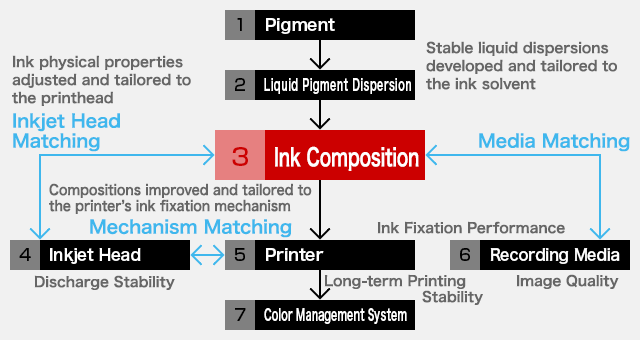
TAKA Material & Systems Laboratory, inc.

INKJET INK
Inkjet Printer Ink Developments by TAKA Material & Systems Laboratory
Development Concept
Inkjet printing is comprehensive technology that becomes useful by functionally linking numerous elements. Beautifully finished printing is perfected and realized by optimizing the overall flow of elements including the ink, printhead, recording media, and print mechanism.
Of these, the element that is considered to be the core technology is the ink. Numerous functions are consolidated in the ink, and during printing, it is the ink that determines performance aspects such as discharge stability, ink fixation performance, image quality, and long-term printing stability.
In other words, an in-depth understanding of ink is essential in order to improve the quality of inkjet printing. You can’t talk about inkjet printing without understanding ink.
Ink is at the core of inkjet technology.

Creating the Liquid Pigment Dispersion
Determining the liquid pigment dispersion specifications and creating a stable dispersion
The ink and the liquid pigment dispersions are in an inextricably linked relationship.
- Implement precise particle size control to achieve excellent image quality without degrading the performance of the colorant (pigment).
- Suppress pigment aggregation and settling to achieve long-term dispersion stability.
- Determine and create the specifications required of liquid pigment dispersions for ink design such as providing a high degree of freedom in ink composition adjustments without limiting the raw materials that can be used.
Inkjet Head Matching
Combining compositions to adjust the physical properties of ink and suppress the occurrence of foreign material and air bubbles
In order to achieve a stable discharge of ink from an inkjet head, the physical property values of static and dynamic behavior such as viscosity, surface tension, pH, and wetting performance with other components must be adjusted. However, the various organic solvents, surfactants, and such that are used to adjust physical properties contain a significant amount of foreign material and substances that cause the generation of air bubbles.
Foreign material and air bubbles are a major cause of nozzle clogging and curved discharge of ink drops. Therefore, compositions are combined to achieve a good balance that enables the adjustment of physical properties while also minimizing the occurrence of foreign material and air bubbles.
Media Matching
Realizing printing on inexpensive recording media that can be used industrially
The ultimate performance required of recording media is wide ranging including a vast scope of color reproduction, reduced granularity, smooth gradation, a high level of fixation performance, water resistance, light resistance, gas resistance, and other practical preservation properties.
These performance requirements are secured even when printing on inexpensive recording media.
Mechanism Matching
Optimized compositions to reduce the load on printers
When the fixation performance of ink on a recording media is increased, the nozzles tend to clog more easily due to aggregation and solidification of the colorant. Therefore, if a printer is not provided with a function to prevent this, an even larger load is imposed on the printer.
On the other hand, if a composition is adopted that decreases the fixation performance in order to suppress clogging in the printhead, an excessive load is applied on the ink fixation mechanism of the printer.
Therefore, compositions are optimized to overcome these tradeoff factors and achieve a good balance with consideration of the overall cost and maintenance ease of the print mechanism.